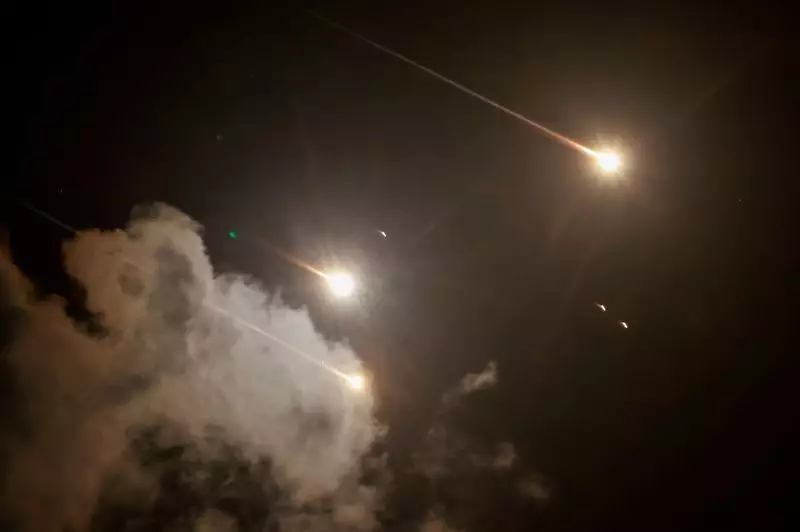In recent months, the geopolitical landscape has been noticeably marked by Iran’s assertive missile strikes on Israel. These attacks, notably a substantial missile barrage in October, have sparked crucial discussions surrounding missile defense efficacy, particularly concerning the U.S. and its Indo-Pacific strategies vis-à-vis Beijing. The variety and volume of missiles launched by Iran—nearly 400 this year—serve as critical data points that illuminate both the strengths and weaknesses of defense systems, and offer invaluable lessons for military strategists worldwide.
Analysts underscore that while the technology and objectives may differ between the Middle East and the Indo-Pacific, the patterns exhibited could provide significant insights into the nature of missile threats and defense capabilities. Collin Koh from the S. Rajaratnam School of International Studies emphasizes that the Iranian missile defense scenario starkly juxtaposes the anticipated challenges that the U.S. might face in countering China’s advanced missile arsenal. This emerging reality urges a reevaluation of deterrent approaches, suggesting that merely relying on defensive tactics may no longer suffice; the emphasis might increasingly need to shift toward deterrence through retaliatory capabilities.
While the Iranian threat has provided a case study in missile defense, the geographical and technological contexts surrounding any potential conflict in the Indo-Pacific set it apart from cases like Israel. The vast distance spanning thousands of kilometers introduces logistical complexities not present in the Israeli context. Furthermore, burgeoning advancements in China’s missile technology threaten to outpace existing defensive measures, including innovations in maneuverable warheads and increased precision.
The United States’ current military adaptations to counter these challenges—such as the deployment of the AIM-174B air-to-air missile and ground-based Typhon missile systems—reflect an ongoing commitment to maintain a robust presence in the region. However, as military experts, including Ankit Panda of the Carnegie Endowment for International Peace, note, understanding the intricacies of offensive capabilities and defensive effectiveness is paramount in avoiding miscalculations that could escalate military conflict.
Indeed, the evolving nature of warfare compels not only a reevaluation of tactics but also of the broader military posture in the region. Conversely, as the large-scale missile offensive from Iran illustrates, knowing how a missile defense system performs can act as a deterrent against conflict escalation. The reality remains, though, that offensive strategies devoid of concrete insights into defensive capabilities can lead to unpredictable outcomes.
The contrast between Israel’s robust multi-layered air defense systems and the United States’ missile defense posture in the Indo-Pacific is particularly telling. Israel utilizes a sophisticated array of interceptive technologies, including the Iron Dome and Arrow systems, designed to counteract varying degrees of threats. These systems have been fine-tuned through years of engagement with specific adversarial tactics and weaponry, primarily focused on guided missiles and shorter-range projectiles.
In stark contrast, the United States and its Indo-Pacific allies deploy systems such as the Lockheed Martin and Raytheon Patriot, THAAD, and Navy’s Aegis, designed to intercept a wider variety of aerial threats. However, the advanced capabilities of China’s missile arsenal, especially those such as the DF-26, pose significant challenges. Although it has been estimated that China’s intermediate-range ballistic missiles possess an accuracy of approximately 150 meters, they are capable of targeting key locations throughout the region, including vital U.S. military installations.
Malcolm Davis from the Australian Strategic Policy Institute articulates an essential observation: Western missile defense systems will face a formidable task in counteracting a coordinated and potentially overwhelming missile strike by China. As military strategists hypothesize, such attacks could be coupled with cyber warfare initiatives designed to paralyze defensive frameworks further, complicating the U.S. and its allies’ response.
The Road Ahead: Strategic Reassessments
The current geopolitical climate necessitates a strategic reassessment, particularly in light of the lessons gleaned from Iran’s missile attacks on Israel and projections regarding China’s military capabilities. The implications of these insights are manifold: military leaders must adapt to a reality where deterrence is redefined, moving away from a sole focus on defensive acceptance to a hybrid approach that emphasizes both defensive capabilities and offensive countermeasures.
As the analysis of missile strike implications continues to evolve, nations must invest in strengthening not only their defensive frameworks but also their overall military alliances and technological advancements. The ultimate goal would be to ensure preparedness against a spectrum of threats while fostering a security architecture that adapts to the changing nature of deterrence in contemporary warfare. The lessons drawn from Iran’s recent actions serve as a clarion call to reassess and recalibrate the intricate balance of defensive and offensive posturing in our global defense strategies, especially in the high-stakes theater of the Indo-Pacific.

